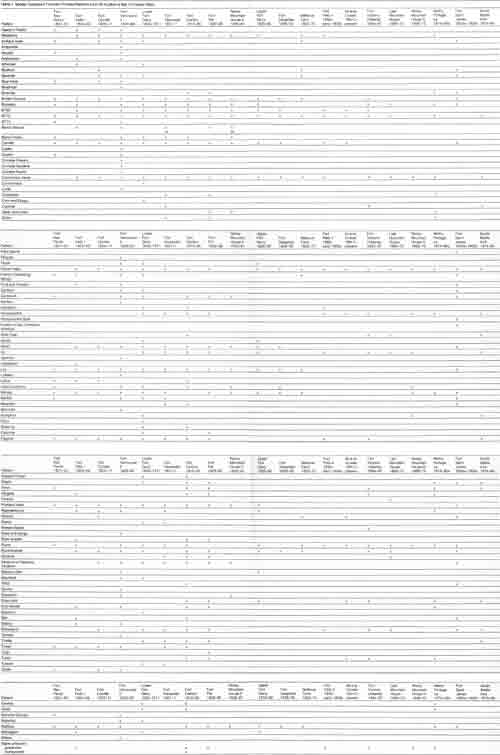Canadian Historic Sites: Occasional Papers in Archaeology and History No. 22
Spode/Copeland Transfer-Printed Patterns Found at 20 Hudson's Bay Company Sites
by Lynne Sussman
The Catalogue
Pattern Names
Unless otherwise noted, the pattern names cited in the catalogue are
those given by the Spode/Copeland company. They have been verified by
the factory pattern books, company catalogues, names engraved on the
copper plates, or pieces on which the pattern name has been printed.
Dates
The date range given for each pattern name includes, in most cases,
the date the pattern was introduced and the latest date for which there
is evidence that the pattern was considered usable by the factory. It
is most unlikely that a pattern with a date range of, say, 50 years was
used continuously throughout that period although it was not uncommon
for the Spode/Copeland company to re-engrave, reintroduce and even
reregister its patterns. For example, Italian, introduced circa 1816,
does not appear in W.T. Copeland and Sons' 1882 catalogue but is being
produced today by Spode Limited.
The introductory date of a pattern is most often deduced from its
lowest recorded number in a Spode/Copeland factory pattern book. These
numbers, when known, are included in the catalogue.
The main Spode/Copeland pattern number series, in use until 1852,
simply began at number one and continued upward with each new pattern.
The series was used to record painted and/or gilded patterns as well as
transfer-printed patterns with painted or gilded embellishments. (The
engraved copper plates for the transfer-print patterns were simply
stored alphabetically by pattern name.) Very little painted or gilded
decoration appears on Copeland transfer-printed ceramics from the 20
Hudson's Bay Company sites; nevertheless, it is still possible to
assign dates to the patterns since most transfer-printed patterns were at
one time embellished with painted or gilded decoration and therefore
received numbers which can be used as indices of the introductory dates
of the basic transfer-print patterns.
In 1822 a secondary numbering system employing the prefix "B" was
introduced for recording underglaze decoration, including
transfer-printing, but was abandoned in 1841 after the recording of
fewer than one thousand patterns.
In 1852 the main pattern series had reached a cumbersome 10,000 and a
new series, in effect a continuation of the main series, was begun using
the prefix "D." Early numbers in the D series were given to variations
of patterns already in the company repertoire. The first D number to
appear with a new pattern was D317 (Copeland 1976a).
By 1874 the D pattern numbers had reached 10,000 and yet another
series was introduced to continue the system. The new series divided
china patterns from earthenware ones by the prefixes "1/" and "2/"
respectively. The allotted 10,000 pattern numbers were eventually
consumed, but not until the 20th century.
Leonard Whiter (1970) produced a reliable dating sequence for the
majority of the main pattern numbers (those used until 1852) by the
painstaking collection of scattered clues in the company records
including dated watermarks in the pattern books. His interest centred
around the Spode period, prior to 1833, and his sequence stops at that
date. Using plentiful watermarks, Whiter also compiled another excellent
dating sequence for the B series (1822-41) (Whiter 1970: 89).
Spode/Copeland pattern numbers are also summarized in a notebook
compiled in 1956 by Sam Williams, the pattern record keeper for W.T.
Copeland and Sons (Spode Limited, Factory pattern number summary ...).
Since Williams used only some of the watermarks as a dating device, his
dates are rather less reliable than Whiter's. Extracts from Williams's
dating keys are presented in Appendix B.
Excavated Material
Reference in the catalogue to excavated examples are limited to
pieces bearing maker's marks. The marks that have been found on
excavated material are described and illustrated in Appendix C and
Figure 249. The occurrence of the various patterns at the 20 sites is
recorded in Table 1.
Colour
No mention of colour is made in the catalogue. Most of the patterns
were printed in a range of colours which were commonly used by other
manufacturers as well. Although different colours were popular at
different times, not enough is known about the introductory or terminal
dates of the colours to make them an effective dating tool.
The Illustrations
The transfer-print patterns are generally shown reduced from their
actual size. In most cases the prints shown are designed for plates
(every different type of object would have its own engraving and print
of a pattern), but some of the prints for other objects are illustrated;
for example, the print for a souptureen (Fig. 23), for a sugarbowl and
creamer (Fig. 203).
The centre designs are occasionally awry. Because the borders and
centres of transfer prints are applied separately, there is no need for
the various design elements to be positioned on the copper plates as
they would appear on the finished pieces.
Besides the patterns themselves, various other elements may appear on
the copper plates. As a general rule these would appear on the backs of
the finished pieces, but were engraved on the same copper plate as the
pattern. Maker's marks appear frequently with the exception of W.T.
Copeland (1847-67) marks which were engraved on separate copper
plates. Registration marks also appear, both the diamond mark, used
from 1843 to 1883, and the simpler "Rd No" and number, used after 1883.
Less frequently seen are club or association insignia or special
inscriptions for custom orders; for example, "Public Rooms, Kamptee"
(Fig. 34), "Rey's Hotel" (Fig. 131).
Table 1. Spode/Copeland Transfer-Printed Patterns from
20 Hudson's Bay Company Sites

(click image for a PDF version of this table)
|

